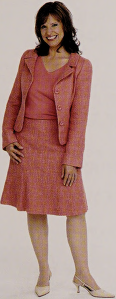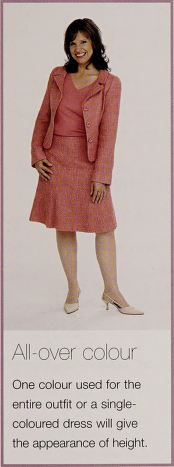
Now you know your best colours, you can combine them to create the look of a balanced body. Lighter or brighter colours will always draw attention to the areas where they’re worn. Below are some of the most frequently used combinations.

One colour used for the entire outfit or a singlecoloured dress will give the appearance of height
Different blocks of colour on a jacket, top, skirt or trousers will give the appearance of reducing height.
A jacket and skirt or trousers in one colour, with a top of another colour, is a great combination for everybody.
Other winning combinations
y A light top with a dark bottom will give the illusion of wider shoulders and slimmer hips, which is perfect for Triangles, but not for Inverted Triangles.
/ A jacket in one colour, with a top and skirt or trousers in another, is a great combination
for every body shape. If you are long in the body, you can break this look up with a belt.
/ A dark top and light bottom will give the illusion of narrower shoulders and wider hips. This combination is excellent for Inverted Triangles but not for Triangles.


details
Your body shape and proportions will determine which clothing details, such as necklines, waistlines and sleeves, will flatter you the most. By learning to look at your body objectively, you will know how to buy clothes to suit your shape.
There is one golden rule that will ensure you are showing off your body shape to best advantage at all times: never finish any part of a garment at the widest point of your body. For example, you should avoid:
X jackets that finish at the widest point on your hips X skirts that end at the fullest part of your legs X short sleeves if you have a full bust X short tops if you have a wide waist
If you don’t wear the right bra, your clothes won’t hang properly: go to page 174 - the wrong bra can alter your body shape and clothing size. Flave a variety of bras to suit different occasions and different tops.
Small bust Add details such as pockets, buttons, applique, ruffles or slogans. Texture and layering are also helpful. A padded bra always helps.
Full bust Stick to simple cuts and plain fabrics (no heavy
textures). A V-neck or jewel neckline is best for you. Front-opening shirts and blouses need to be worn with care, and should be made of soft or stretchy fabric.
When deciding which necklines to wear, be aware of how prominent your collarbones and/or your upper chest are, and of how confident you feel to reveal these parts of your body.
Boat/slash | Give the illusion of wide shoulders. Good for Triangle shapes, but avoid if you have prominent collarbones or a scrawny neck. |
Bardot | Good for most shapes, but not if you have sloping shoulders. |
V-necks | Look good on everyone, and can always be accessorized. Plunging V-necks are elegant - but not if you have a long neck or if they reveal too much cleavage. |
Scoop | Work well on most women, particularly if you have narrow shoulders. |
Cowl | Perfect for full busts and softer body lines. |
Roll | Only if you have a long neck and no double chin. |
Crew | Suit most women, but they need to sit well. |
Ruffles/frills | Best for a longer neck and softer features. |
Table captionMandarin collars Not for those with a short neck or double chin
Shirt collars | Good for all women, and best worn open. |
Jewel necklines | Good for all. |
Halternecks | Excellent for Inverted Triangles. |
Inserted | Good for all. If your shoulders slope or are rounded, consider shoulder pads. |
Raglan | You need a square shoulder line to wear these. |
Dropped | Good for adding width to the shoulders. They will also soften a strong shoulder line. |
The key factor when choosing a sleeve length is to remember never to end the sleeves at a wide point on your arm.
Bracelet Great for short to average arms.
Full Best for average to long arms.
Batwing Best worn by average to tall women.
Cuff details Make sure that these do not overwhelm your hands.
Create the illusion of a longer body by wearing a low waistline;
to shorten your body, bring the waistline up.
Waistband You need to have a clearly defined waist, as in Neat Hourglass, Full Hourglass and Triangle shapes, to wear trousers and skirts with waistbands. A wide waistband is excellent if you are long-waisted.
Elasticized These may be your favourites if you have a fluctuating waistline. Best worn covered over but beware of adding bulk. Non-gathered elasticized waistbands are more flattering.
Dropped waist Perfect for short-waisted women, but they don’t work well for long-waisted women.
Hipsters Good for short waists and those of you who do not have clearly defined waistlines (Inverted Triangles, Rectangles or Lean Columns).
Decide where the widest part of your bottom is and avoid any
details in that area. Instead of wearing a long jacket or top
to hide your bottom, show off an asset such as your waist.

Front pleats Good if you have a flat tummy.
Zips Front zips will add volume to your tummy;
side and back zips will give a sleeker look.
Pockets Pockets with flaps suit women with flat hips.
Sloping pockets and pockets without flaps can be worn by everyone.
Belts
Great for averting the eye from a full waistline.
If your thighs are wider than your hips, take care to avoid details in the thigh area. Looser fitting trousers and skirts are the answer.
Short legs Wear skirts and trousers with minimal volume.
Open-fronted shoes with a short skirt will add length to the leg, as will tights or socks in the same colour as your trousers or skirt. Avoid details and patterns.
Long legs
Wear skirts and trousers with lots of volume and detail. Patterns and layers are good for you.
Skinny legs
Add volume with textured tights and fabrics. Avoid anything too clingy.
Wide legs Wear the same colour from waist to toes.
Avoid anything too clingy or heavily textured. Loose and fluid fits work well.
Thin Add details such as ankle straps, socks
or different textures.
Wide
Go for open-fronted shoes.